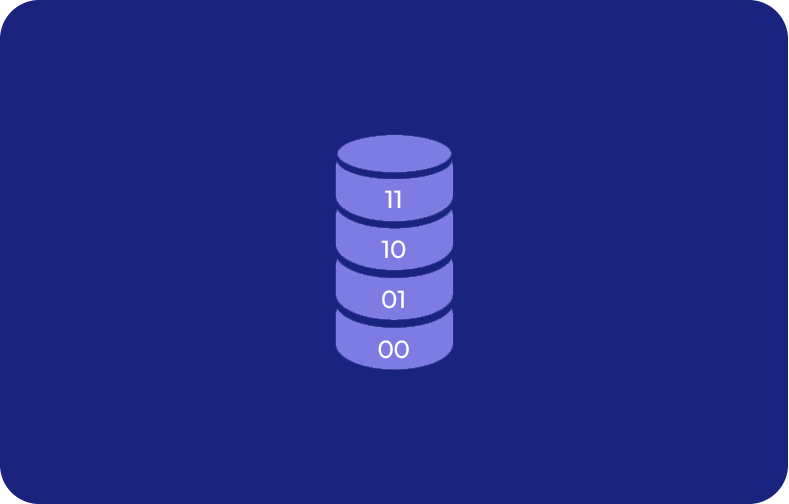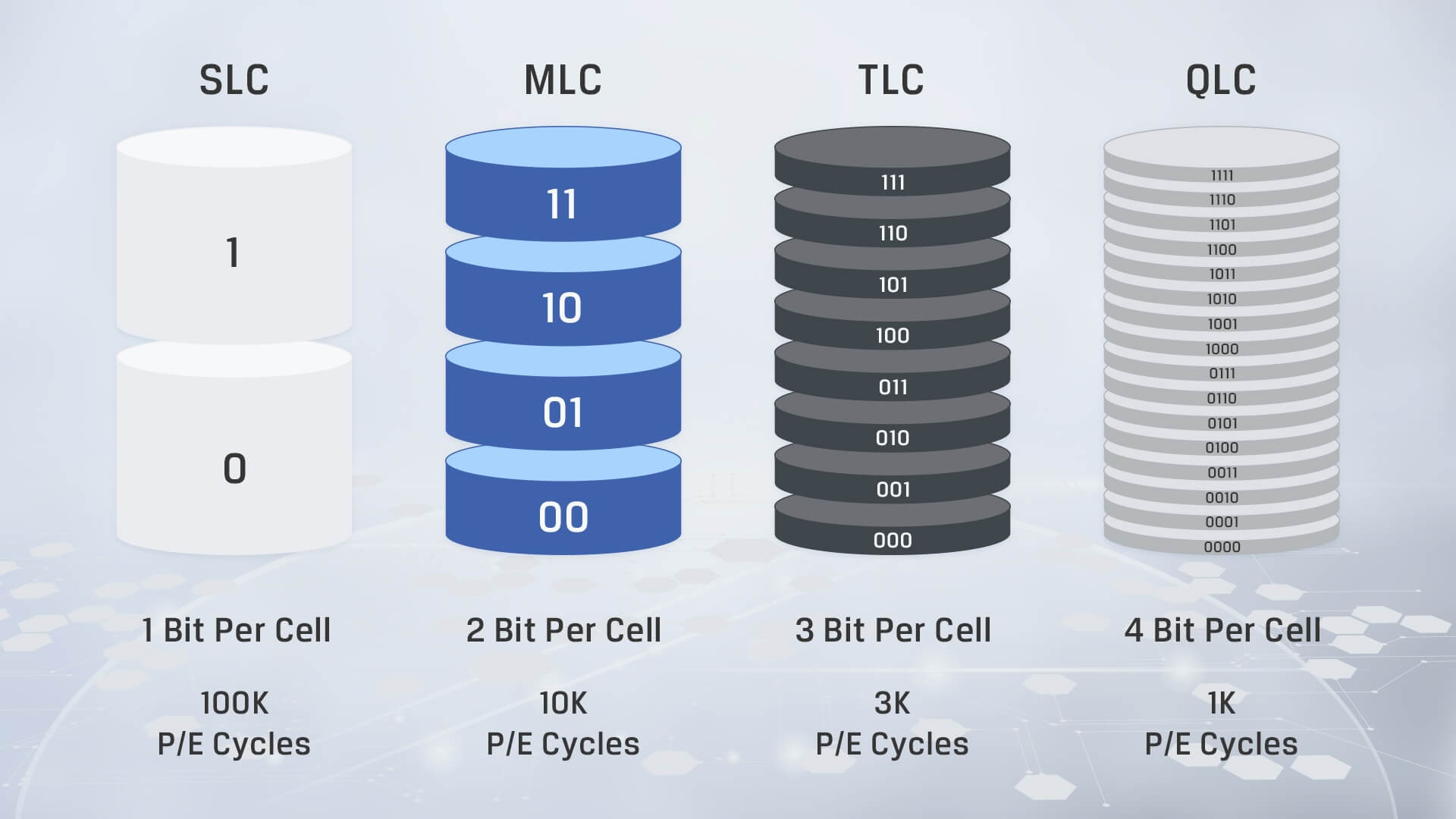What Are MLC and TLC? Which is better?

Multi-Level cells (MLC) and Triple-Level cells (TLC) are NAND flash memory technologies that have transformed the landscape of storage devices, particularly Solid State Drives (SSDs).
Despite the remarkable price decline and increased manufacturing efficiency, flash storage remains more expensive than hard disks of the same capacity. Additionally, flash memory has a limited lifespan, which restricts the number of times data can be written to it, rated in P/E cycles. However, engineers have devised a solution by increasing the data capacity of each cell in NAND, allowing for greater storage capacity in SSDs.
MLC and TLC enable higher storage capacities, improved performance, and cost-effective solutions for various applications. Understanding the key differences between the two NAND technologies is essential to determine which technology is better suited for specific needs.
What is NAND Flash Storage?

NAND flash storage is a non-volatile technology widely used in various devices. Unlike volatile memory, NAND retains data even when the power is turned off, making it an ideal choice for internal, external, and portable devices that hold data. Devices such as USB drives, Solid State Drives (SSDs), and SD cards utilize NAND flash technology, providing ample storage for mobile phones, digital cameras, and more.
MLC SSD
MLC NAND technology stores multiple bits of data per memory cell, typically 2 bits. It employs voltage levels to represent different data states, allowing for increased storage density. The advantages of MLC include:
-
It enables larger storage capacities with multi-bit storage per cell.
-
It offers improved performance with faster read and write speeds.
-
MLC SSDs have better endurance for write-intensive workloads.
TLC SSD
TLC NAND technology furthers storage density by storing three bits per memory cell. This higher bit also affects certain aspects of TLC, including:
-
It is cost-effective with lower manufacturing expenses.
-
It provides higher storage capacities at an affordable price.
-
TLC has slightly lower endurance than MLC, but recent advancements have addressed this.
Best Use Cases for TLC and MLC NAND Flash Memory
Triple-Level Cell (TLC)
-
Consumer-grade SSDs for everyday computing applications.
-
USB flash drives for affordable data storage and transfer.
-
Memory cards for digital cameras and smartphones.
-
Cloud storage applications focused on economical data storage.
Multi-Level Cell (MLC)
-
Enterprise-grade SSDs for high-performance computing applications.
-
Industrial and automotive applications that require reliability and durability.
-
High-performing computing applications for scientific research and data analysis.
-
Content creation applications such as editing and graphic design
Similarities between MLC and TLC SSDs
MLC & TLC, two commonly used Solid State Drive (SSD) technologies, share several key similarities:
Memory Cell Structure: Both use a similar memory cell structure, storing data by trapping electrons in a floating gate within a transistor.
Increased Storage Density: They offer higher storage densities than older technologies, allowing more data to be stored in a smaller physical space.
Energy Efficiency: MLC & TLC SSDs show lower power consumption than traditional hard drives, making them energy-efficient options for portable devices.
Advanced Error Correction: They demand advanced error correction techniques to ensure data reliability and retain data integrity.
MLC V/S TLC SSD drive
Performance: MLC SSD generally offers better performance than TLC. MLC has a lower bit density, allowing for faster read & write speeds compared to a TLC drive. This makes MLC more suitable for high-speed data access applications, such as gaming or professional use.
Endurance refers to a NAND cell's ability to withstand program-erase cycles without degradation. MLC typically exhibits higher endurance compared to TLC. MLC memory cells can endure more program-erase cycles before experiencing performance degradation, making them better suited for write-intensive applications like servers or data centers.
Cost and Capacity: TLC is more economical and provides higher storage capacities than MLC. TLC stores three bits per cell, while MLC stores two. The higher bit density of TLC allows for more data storage in each cell, resulting in larger capacities at a lower cost. TLC is commonly used in consumer-grade SSDs, where low value and capacity are crucial factors.
Reliability: MLC offers better reliability due to its lower bit density. The lower number of data bits stored in each cell reduces the chance of errors occurring during read and write operations. This reliability factor makes MLC more suitable for applications that require critical data storage, such as enterprise-level systems.
Use Cases: MLC is often preferred for professional and high-performance applications like database management or virtualization. Its superiority makes it ideal for these demanding scenarios. On the other hand, TLC is well-suited for consumer applications, such as laptops, gaming consoles, and personal computing, where cost and capacity are more important considerations.
Longevity: MLC typically offers a longer lifespan than TLC. With their lower bit density and higher endurance, MLC-based SSDs can sustain more program-erase cycles before wearing out. This aspect is crucial for applications where long-term reliability and longevity are paramount.
Final Word
In conclusion, MLC & TLC are two powerful NAND flash memory technologies that have greatly impacted the storage industry. MLC stores 2 bits per memory cell to achieve higher densities, while TLC stores 3 bits per cell, allowing for higher storage densities than older technologies.
The choice between MLC and TLC depends on specific requirements and priorities. MLC offers superior performance, endurance, and reliability, making it well-suited for professional-grade applications that demand higher data integrity, such as data centers and video editing. On the other hand, TLC provides a more efficient solution with larger storage capacities, catering to consumer-grade devices like laptops, gaming consoles, and personal computing.
Ultimately, deciding which NAND technology is better depends on performance needs, budget constraints, and required storage capacities. It is crucial to carefully evaluate these factors and consider the specific demands and different characteristics of the intended application to decide whether MLC or TLC is the better choice.
Frequently Asked Questions
What is MLC & TLC?
MLC stands for Multi-Level Cell, while TLC stands for Triple-Level Cell. They are NAND flash memory technologies that store data in storage devices like SSDs.
How do they differ?
The main difference lies in the number of bits they store per memory cell. MLC stores 2 bits, while TLC stores 3 bits per cell, resulting in different performance, cost characteristics, and bearing.
Which is better, MLC or TLC?
The choice depends on specific requirements. MLC offers better performance and endurance but at a higher cost, while TLC provides higher capacity and lower cost but with slightly lower performance and endurance.
What are the advantages of MLC?
MLC offers faster read and writes speeds, better endurance, and higher reliability. It is suitable for professional and high-performance applications that require speed and durability.
What are the advantages of TLC?
TLC provides larger storage capacities at a lower cost, making it ideal for consumer-grade applications like laptops, gaming consoles, and personal computing.
Which is more cost-effective, MLC or TLC?
TLC is generally more economical due to its higher bit density, allowing greater storage capacities at a lower manufacturing cost.
Can the two be used interchangeably?
It depends on the specific requirements of the application. MLC & TLC have different performance and endurance characteristics, so choosing the appropriate technology based on the intended use is essential.
Are there any reliability concerns with MLC or TLC?
They can both provide reliable performance, but MLC offers better reliability due to its lower bit density, reducing the chance of errors occurring during data operations.
What applications benefit from MLC?
MLC is well-suited for professional and high-performance applications, such as video editing, database management, or virtualization, where speed, endurance, and reliability are crucial.
What applications benefit from TLC?
TLC is commonly used in USB flash drives and consumer applications, where cost and storage capacity are more significant factors than extreme performance and bearing.








.png)


